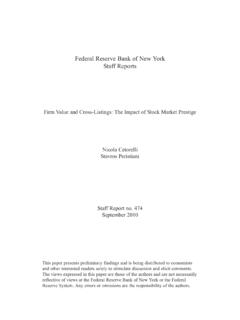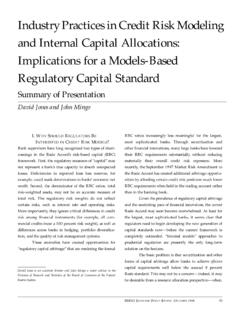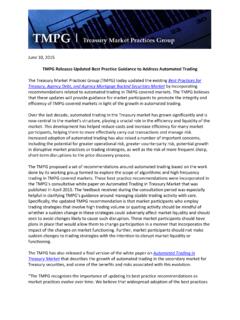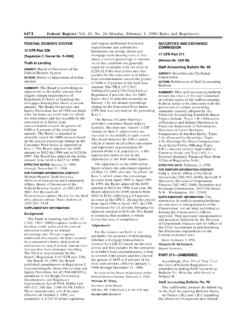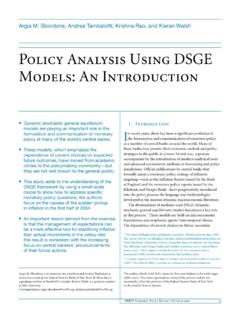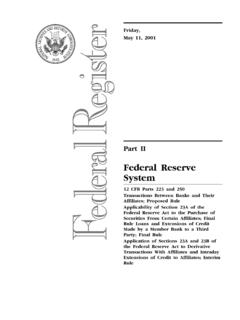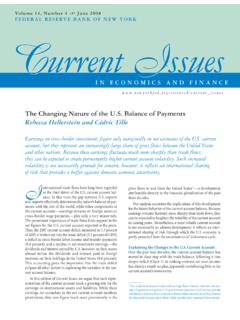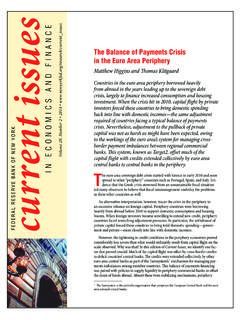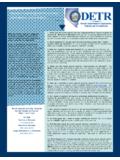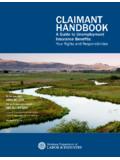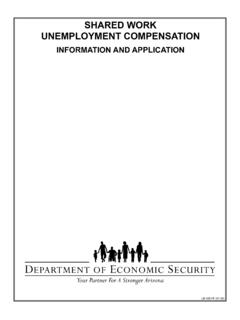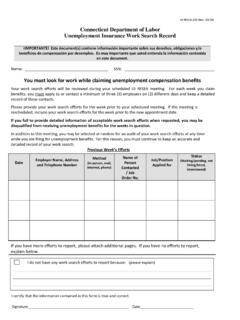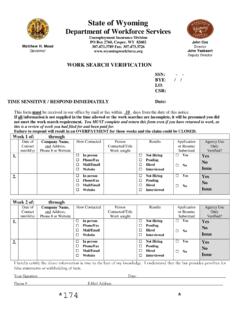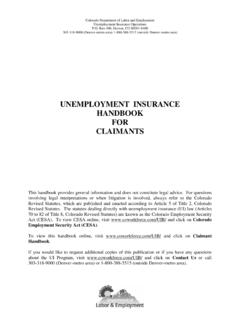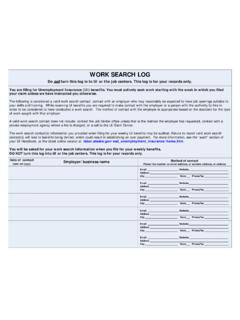Transcription of Unemployment Benefits and Unemployment in the Great ...
1 This paper presents preliminary findings and is being distributed to economists and other interested readers solely to stimulate discussion and elicit comments. The views expressed in this paper are those of the authors and do not necessarily reflect the position of the Federal Reserve Bank of New York or the Federal Reserve System. Any errors or omissions are the responsibility of the authors. Federal Reserve Bank of New York Staff Reports Unemployment Benefits and Unemployment in the Great Recession: The Role of Equilibrium Effects Marcus Hagedorn Fatih Karahan Iourii Manovskii Kurt Mitman Staff Report No. 646 October 2013 Revised September 2019 Unemployment Benefits and Unemployment in the Great Recession: The Role of Equilibrium Effects Marcus Hagedorn, Fatih Karahan, Iourii Manovskii, and Kurt Mitman Federal Reserve Bank of New York Staff Reports, no.
2 646 October 2013; revised September 2019 JEL classification: E24, J63, J64, J65 Abstract Equilibrium labor market theory suggests that Unemployment benefit extensions affect Unemployment by impacting both job search decisions by the unemployed and job creation decisions by employers. The existing empirical literature focused on the former effect only. We develop a new methodology necessary to incorporate the measurement of the latter effect. Implementing this methodology in the data, we find that benefit extensions raise equilibrium wages and lead to a sharp contraction in vacancy creation and employment and a rise in Unemployment . Key words: Unemployment insurance , Unemployment , employment, vacancies, wages, search , matching _____ Karahan: Federal Reserve Bank of New York (email: Hagedorn: University of Oslo (email: Manovskii: University of Pennsylvania (email: Mitman: Institute for International Economic Studies, Stockholm University (email: This paper was previously circulated under the title Unemployment Benefits and Unemployment in the Great Recession: The Role of Macro Effects.))))
3 The authors thank Bob Hall, Sam Schulhofer-Wohl, and seminar participants at Bocconi, Bonn, Census Bureau, Columbia, Edinburgh, EIEF, USC, Maryland, Penn State, UPenn, Princeton, Pompeu Fabra, Toronto, Toulouse, UCL, UConn, Wisconsin, CUNY Graduate Center, Greater Stockholm Macro Group, Federal Reserve Banks of Cleveland, New York, and Philadelphia, 2013 conference on Macroeconomics Across Time and Space, 2013 SED, 2013 NBER Summer Institute (EFCE, EFMB, EFRSW groups), 2013 North American Summer Meeting of Econometric Society, 2013 Minnesota Workshop in Macroeconomic Theory, 15th IZA/CEPR European Summer Symposium on Labor Economics, Mannheim conference on Financial Frictions and Real Economy, 4th Ifo Conference on "Macroeconomics and Survey Data," 2014 ASSA Meetings, 2014 NBER Public Economics Program Meeting, 2014 Cowles Foundation Summer Conference on Structural Empirical Microeconomic Models" and 2018 ERMAS conference for their comments.
4 The authors are especially grateful to June Shelp, at The Conference Board, for her help with the HWOL data. Support from the National Science Foundation Grants No. SES-0922406 and SES-1357903 is gratefully acknowledged. The views expressed in this paper are those of the authors and do not necessarily reflect the position of the Federal Reserve Bank of New York or the Federal Reserve. 1 IntroductionUnemployment in the rose dramatically during the Great Recession and remained atan unusually high level for a long time. The policy response to the initial rise in unemploymentduring the financial crisis involved an unprecedented extension of Unemployment Benefits withbenefit duration rising from the usual 26 weeks to as long as 99 weeks.
5 The motivation for thispolicy was to provide income support for a vulnerable group after they have lost their jobsthrough no fault of their own as well as needed support for the fragile economy. 1 The effectiveness of this policy response was questioned by Barro (2010) and Mulligan(2012), among others. These researchers pointed out that the fact that Unemployment benefitextensions represent an implicit tax on market work may offset some of the stimulative effectascribed to such policies and help explain the persistence of high Unemployment even afterthe end of the Great Recession. Recent careful microeconometric studies have challenged thisargument by documenting only small effects of Unemployment benefit extensions on labor sup-ply.
6 The methodology underlying the existing empirical research, however, does not allow fora complete evaluation of the effects of Unemployment benefit extensions because it excludesthe possibility that this policy could also impact labor demand. We develop a novel measure-ment methodology required to incorporate this effect and attempt to provide a more completeempirical assessment of the labor market implications of this policy following stylized decomposition helps illustrate the two margins:Job finding rateit=sit search intensity f( t) finding rate per unit ofs(1)In words, the probability that an individualifinds a job at timetdepends on how hard thatindividual searches and how selective he is in his acceptance decisions, which is captured by the search effort componentsit.
7 It also depends on the aggregate labor market conditions tthatdetermine how easy it is to locate jobs by expending a unit of search effort. To use an extremeexample, if there are no job vacancies created by employers,f( t) = 0, no amount of searcheffort by an unemployed worker would yield a positive probability of obtaining a in Unemployment benefit policies affect both the search intensity of unemployedworkers - the micro effect, and the aggregate job finding rate per unit of search effort throughgeneral equilibrium macro effects. Indeed, in the classic equilibrium search framework ofMortensen and Pissarides (1994), the primary analytical device used by economists to studythe determination of Unemployment , the response of Unemployment to changes in Benefits ismainly driven by the response of employers decisions of whether and how many jobs to createand not by the impact on workers job search and acceptance decisions.
8 The logic of the model1 Unemployment insurance Extensions and Reforms in the American Jobs Act, the report by the Presi-dent s Council of Economic Advisers, the National Economic Council, the Domestic Policy Council, and theDepartment of Labor, December simple. Everything else equal, extending Unemployment Benefits exerts an upward pressureon the equilibrium wage. This lowers the profits employers receive from filled jobs, leading to adecline in vacancy creation. Lower vacancies imply a lower job finding rate for workers, whichleads to an increase in (1978) was probably the first to call for the analysis of the impact of policies onequilibrium market-level Unemployment rates rather than merely individual transitions out ofunemployment.
9 Starting with the pioneering work of Millard and Mortensen (1997) and Shiand Wen (1999), the evidence on the magnitude of these equilibrium effects is predominantlybased on the estimation of structural models based on Mortensen and Pissarides (1994).2 Forexample, a structural analysis based on this model in Krause and Uhlig (2012) reveals a largereduction in Unemployment and increase in vacancy creation due to the benefit duration cut(known as Hartz IV reform) in Germany. The firm s vacancy creation decision in this model isbased on comparing the cost of creating a job to the profits the firm expects to obtain fromhiring the worker. The profit is defined as the difference between a worker s productivity and thewage.
10 Costain and Reiter (2008), Hagedorn and Manovskii (2008) and Ljungqvist and Sargent(2017) have shown that if profits are relatively small, changes in Unemployment benefit policiesthat affect wages can have a large percentage impact on profits, implying a large response ofvacancies, and, as a consequence, of Unemployment . The key parameter determining the sizeof profits in the model is the flow utility obtained by unemployed workers. This parameteris notoriously difficult to measure directly but its value is crucial for the magnitude of policyeffects delivered by the search model. Our objective in this paper is to directly measure theimpact of Unemployment Benefits on the labor market variables of interest without having torely on the estimate of the flow utility of the unemployed and without having to fully specify themodel.
